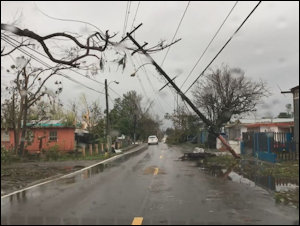
Downed power lines in Puerto Rico. Photo credit: ABC News.
Virginia has enjoyed a welcome respite from meteorological history, having dodged full-fledged hurricanes since Hurricane Isabel struck the Old Dominion in 2003 and Hurricane Gaston in 2004. But sooner or later, we’ll get hammered again. After surveying the devastation of Puerto Rico by Hurricane Maria, made worse by the total collapse of the territory’s electric grid, we Virginians should be asking ourselves how well our electric grid would stand up to a Category 4 hurricane — and what can we do to make it more resilient.
Two potential actions come immediately to mind: burying distribution lines and decentralizing the grid.
Last year Dominion Virginia Power advanced a $2 billion plan to bury the utility’s most outage-prone and difficult-to-repair electric distribution lines to limit the loss of electricity during severe weather events and speed the restoration of electric power. The company said the improvements would cut disruption of service to customers in half after a major hurricane. While the State Corporation Commission approved a small-scale version of the plan, it rejected the full-scale proposal as not worth the cost to rate payers.
There are alternatives to burying electric lines, such as hardening sub-stations, installing sensors that provide early-warning detection of damage, and aggressively pruning trees along right of way. But with the example of a prostrate Puerto Rico before our eyes, one might be more inclined to err on the side of caution. The wisdom of the line-burial policy depends upon the numbers — the cost of burying the lines, the cost of the alternatives, the number of people affected, the likelihood of a major hurricane or other natural disaster, and the economic value lost due to disrupted electric service. I don’t know if anyone has assembled all those numbers, but the topic is serious enough that someone — Dominion, perhaps, or state government — should pull them together for the public to digest.
Others have suggested that Virginia should move toward a distributed electrical grid, less dependent upon central power stations and endless miles of transmission and distribution lines. A distributed grid would rely instead upon wind and solar, batteries, and microgrid technology that allows local circuits to operate independently of the larger system. In theory, local islands of electric power would function even if the larger system were thrown into disarray.
Slate magazine describes Higashi Matsushima, Japan, in the aftermath of the earthquake that knocked out the Fukushima nuclear power plant:
After losing three-quarters of its homes and 1,100 people in the March 2011 tremblor and tsunami … The city of 40,000 chose to construct micro-grids and de-centralized renewable power generation to create a self-sustaining system capable of producing an average of 25 percent of its electricity without the need of the region’s local power utility.
The city’s steps illustrate a massive yet little known effort to take dozens of Japan’s towns and communities off the power grid and make them partly self-sufficient in generating electricity.
Sounds great. But questions arise. How well would Americans function with only 25% of their electricity supply? Also, how well do solar panels hold up in 120 mile-per-hour winds? Some pro-solar sources on the Web say that panels are designed to withstand up to 140 m.p.h. Do those claims withstand scrutiny?
Another issue is what happens when a massive weather system blots out the sun for days at a time. Batteries might be able to store power for a day, but solar + batteries could leave leave owners of rooftop solar bereft of electricity until the storm front passes and the sun reappears. On the other hand, Inside Climate News reports that, while Hurricane Irma cut power to 6.7 million Floridians, homeowners with rooftop solar arrays did just fine.
If unbiased reporting and analysis backs up such claims, perhaps Virginia needs to discuss how to move more expeditiously towards a distributed grid. That would mean solving tricky issues like net metering — whether to charge rooftop solar owners for access to backup power from the larger grid. A mediation initiative is trying to work through that question now. Perhaps Puerto Rico’s plight will provide the stakeholders with a heightened sense of urgency.


